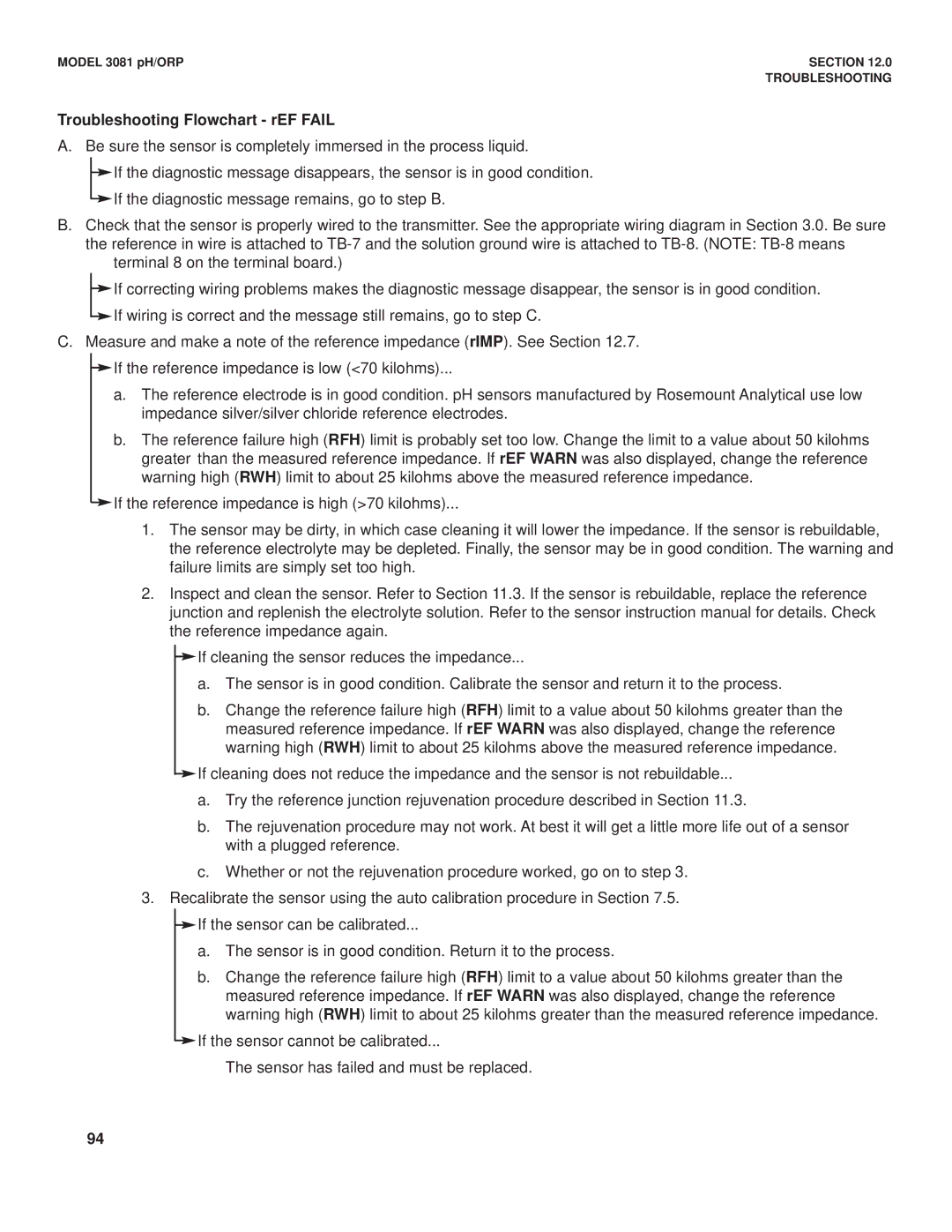
MODEL 3081 pH/ORP | SECTION 12.0 |
| TROUBLESHOOTING |
Troubleshooting Flowchart - rEF FAIL
A. Be sure the sensor is completely immersed in the process liquid.
If the diagnostic message disappears, the sensor is in good condition.
If the diagnostic message remains, go to step B.
B.Check that the sensor is properly wired to the transmitter. See the appropriate wiring diagram in Section 3.0. Be sure the reference in wire is attached to
terminal 8 on the terminal board.)
If correcting wiring problems makes the diagnostic message disappear, the sensor is in good condition. If wiring is correct and the message still remains, go to step C.
C.Measure and make a note of the reference impedance (rIMP). See Section 12.7.
![]() If the reference impedance is low (<70 kilohms)...
If the reference impedance is low (<70 kilohms)...
a.The reference electrode is in good condition. pH sensors manufactured by Rosemount Analytical use low impedance silver/silver chloride reference electrodes.
b.The reference failure high (RFH) limit is probably set too low. Change the limit to a value about 50 kilohms greater than the measured reference impedance. If rEF WARN was also displayed, change the reference warning high (RWH) limit to about 25 kilohms above the measured reference impedance.
If the reference impedance is high (>70 kilohms)...
1.The sensor may be dirty, in which case cleaning it will lower the impedance. If the sensor is rebuildable, the reference electrolyte may be depleted. Finally, the sensor may be in good condition. The warning and failure limits are simply set too high.
2.Inspect and clean the sensor. Refer to Section 11.3. If the sensor is rebuildable, replace the reference junction and replenish the electrolyte solution. Refer to the sensor instruction manual for details. Check the reference impedance again.
If cleaning the sensor reduces the impedance...
a.The sensor is in good condition. Calibrate the sensor and return it to the process.
b.Change the reference failure high (RFH) limit to a value about 50 kilohms greater than the measured reference impedance. If rEF WARN was also displayed, change the reference warning high (RWH) limit to about 25 kilohms above the measured reference impedance.
If cleaning does not reduce the impedance and the sensor is not rebuildable...
a.Try the reference junction rejuvenation procedure described in Section 11.3.
b.The rejuvenation procedure may not work. At best it will get a little more life out of a sensor with a plugged reference.
c.Whether or not the rejuvenation procedure worked, go on to step 3.
3.Recalibrate the sensor using the auto calibration procedure in Section 7.5.
![]() If the sensor can be calibrated...
If the sensor can be calibrated...
a.The sensor is in good condition. Return it to the process.
b.Change the reference failure high (RFH) limit to a value about 50 kilohms greater than the measured reference impedance. If rEF WARN was also displayed, change the reference warning high (RWH) limit to about 25 kilohms greater than the measured reference impedance.
If the sensor cannot be calibrated...
The sensor has failed and must be replaced.
94
